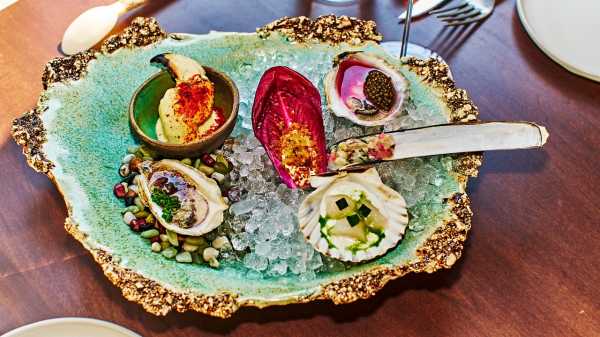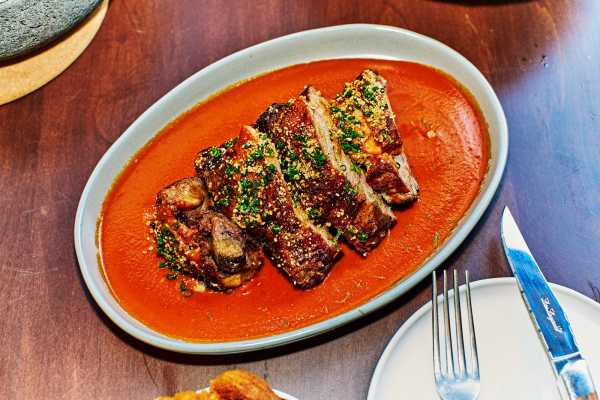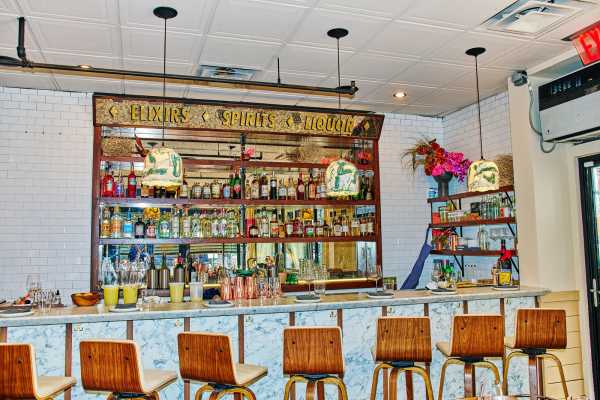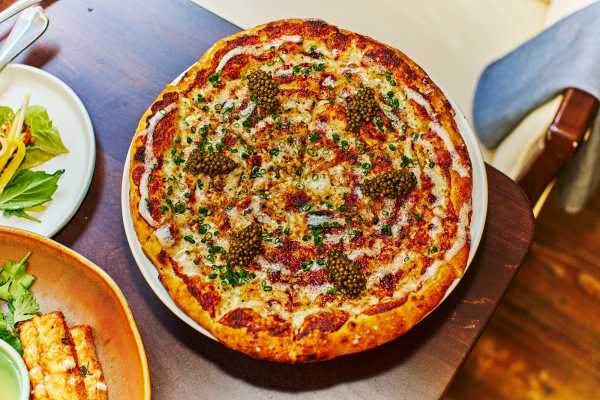
Save this storySave this storySave this storySave this storyYou’re reading the Food Scene newsletter, Helen Rosner’s guide to what, where, and how to eat. Sign up to receive it in your inbox.
The chef duo Samuel Clonts and Raymond Trinh first worked together at the Dove Mountain Ritz-Carlton in Arizona, a high-end hotel, then both made their way to New York, where they worked under the acclaimed chef César Ramírez, at Chef’s Table at Brooklyn Fare. The pair eventually struck out on their own, in 2021, with a laid-back, excellent tasting-menu restaurant on the Lower East Side. Called 63 Clinton, it is one of those places that I hesitate to ever mention in public, lest it become impossible to get into, or the chefs ratchet up the hundred-and-twelve-dollar price, a relative steal for seven thrilling courses. What I love about it most is its idiosyncrasy, its total confidence in itself, its relentless lack of interest in playing the fancy-schmanciness game that seems to steer so many high-end restaurants toward a kind of anodyne, luxury sameness. Despite opening just a few years ago, 63 Clinton feels—wonderfully, soothingly—like a throwback to the auteurish, rock-star-chef heyday of the early twenty-tens. You get the sense that it is run by people who are interested in chasing down ideas, in playing around, and in adhering to a dangerously loosey-goosey sort of business model entirely dependent on their taste, skill, and self-assurance, which in the case of Clonts and Trinh are blessedly high.

Pizzas with inventive toppings are cooked in a tile-adorned domed oven.
Cactus Wren, a new spot that the two opened in February, on Ludlow and Rivington Streets, is similarly sui generis, in that it seems broadly divorced from trends and totally uninterested in capturing any sort of Zeitgeist. It tells a bit of a story, with recurring references to the American Southwest (the restaurant is named after the state bird of Arizona, a wee brown blob of fluff known for its sputtering-motor call), but mostly it’s a kitchen that’s doing its own thing. The menu is tight and snacky, elegant and gimmicky, high and low. In its pursuit of, well, whatever the hell it’s pursuing, Cactus Wren explodes categories, in a way that feels unaffected and invigorating. Ingredients and techniques are woven and swapped from dish to dish, as if in a kitchen-pantry game of Mad Libs. Of course a whopping scoop of osetra caviar should top a bowl of seven-layer bean dip, which includes a ruffly collar of tiny potato chips; it’s no fussier or higher-concept than presenting a quenelle of roe with crème fraîche and blini. Why not fry chicken wings in an airy batter and sprinkle them with jalapeño powder? They taste both intense and beautifully light, and look like giant matcha-colored beignets. Meanwhile, the actual beignets at Cactus Wren are filled with hunks of langoustine, takoyaki-style, and seasoned with Old Bay, very Maryland; the Maryland shrimp, in turn, get piled on small triangles of sandwich bread and deep-fried, as an homage to shrimp toast, the dim-sum classic, which comes with a very non-dim-sum side of green-goddess sauce for dipping.

Pork ribs with salsa roja. Not pictured: a cactus-shaped side of corn bread.

A Brooklyn-based artist made the light fixtures above the bar and the platters on which many dishes are served.©HeamiLee
Every dish feels like a big swing, or contains a little wink. An entrée of pork ribs—short-cut, massively meaty, rubbed with southwestern spices and slow-cooked to collapsing tenderness—comes atop a pool of bittersweet salsa roja, with a side of jalapeño-studded corn bread baked into the shape of a saguaro cactus. I might be tempted to call it TikTok bait, except that the restaurant wears the gag so lightly that it feels scrappy and sincere. Not a single bite, in any of my visits, elicited a note of regret: sure, the wood-fired pizzas read a tad more like flatbreads, with yeasty crusts that lack a pizza’s proper snap and chew, but I nevertheless adored a seasonal pie topped with soft morel mushrooms and a pesto as green and lush as the woods in a rainstorm, and a simpler one dressed with gooey Comté and a drizzle of honey. (You can add caviar to that one for an extra forty-five dollars—a far nicer home for little luxuries than the slightly busy bean dip, and the caviar is ladled out in another obscene portion.)

A Comté-and-honey pizza comes with an option to add caviar.©HeamiLee
Helen, Help Me!
E-mail your questions about dining, eating, and anything food-related, and Helen may respond in a future newsletter.
The space is bright and open, with high ceilings and large windows that highlight the eternally terrific people-watching of the Lower East Side. The mint corner location is the former home of an outpost of Serafina, a chain known for its wood-fired pizzas, which explains the enormous domed oven taking up a quarter of the dining room. The oven, with its colorful tiles is somewhat visually cacophonous, given the understated rusticity of the rest of the room. Glowy porcelain light fixtures, translucent white streaked with rivers of darkness, give the impression of the nacreous interiors of oyster shells, or molded slices of Gorgonzola. They’re the work of the artist Nicole Pilar, who also made the interestingly multi-textured, organic-shaped platters on which many of the courses at 63 Clinton are served. At Cactus Wren, these platters show up beneath the appetizer of fruits de mer, a dish appealingly sized for one, featuring a rotating selection of composed bites that on my visits included dressed raw oysters and clams, Jonah-crab claws, and a Gilda skewer of raw tuna and shiso leaf. Indeed, the restaurant strikes me as a perfect choice for solo dining: belly up to the bar for a glass from the strong wine list, which foregrounds small producers, and order something to nibble on, or dive into, or bask in. On one of my visits, I found myself seated next to a woman indulging, with exquisite poise, in a glass of wine, a book, and what seemed to be every single caviar dish on the menu. There’s a lesson there for us all: it’s important, sometimes, to do exactly what you want to do, and to let yourself enjoy it. ♦
Sourse: newyorker.com







